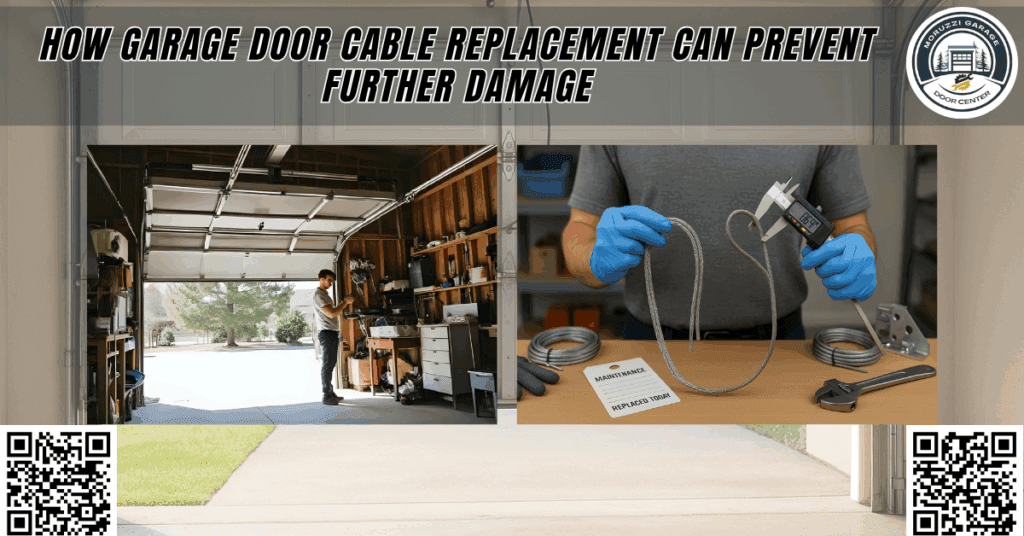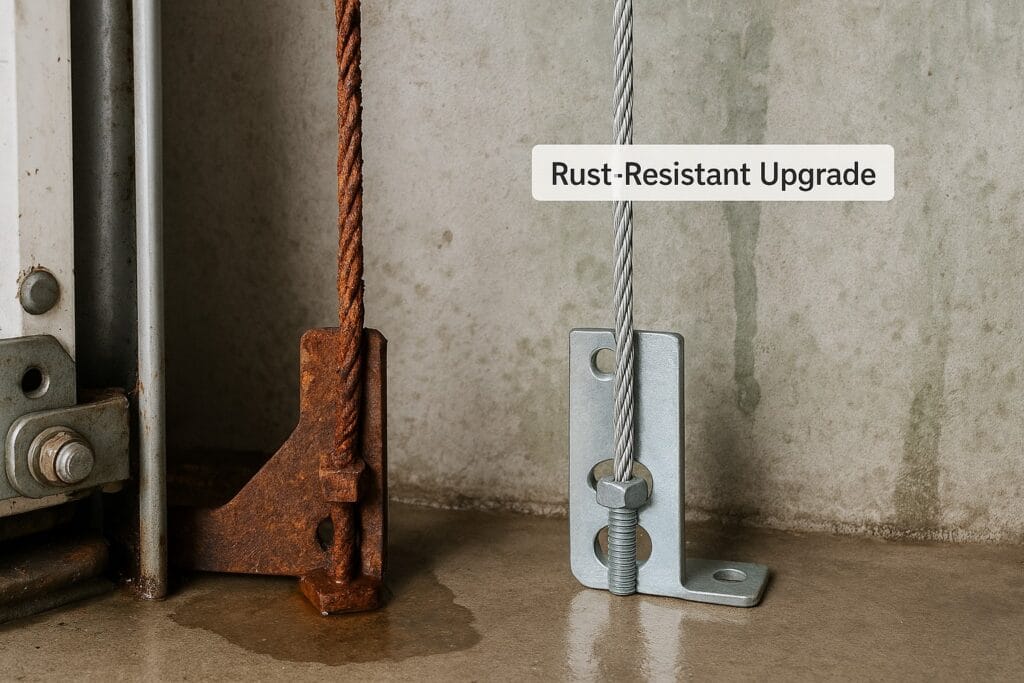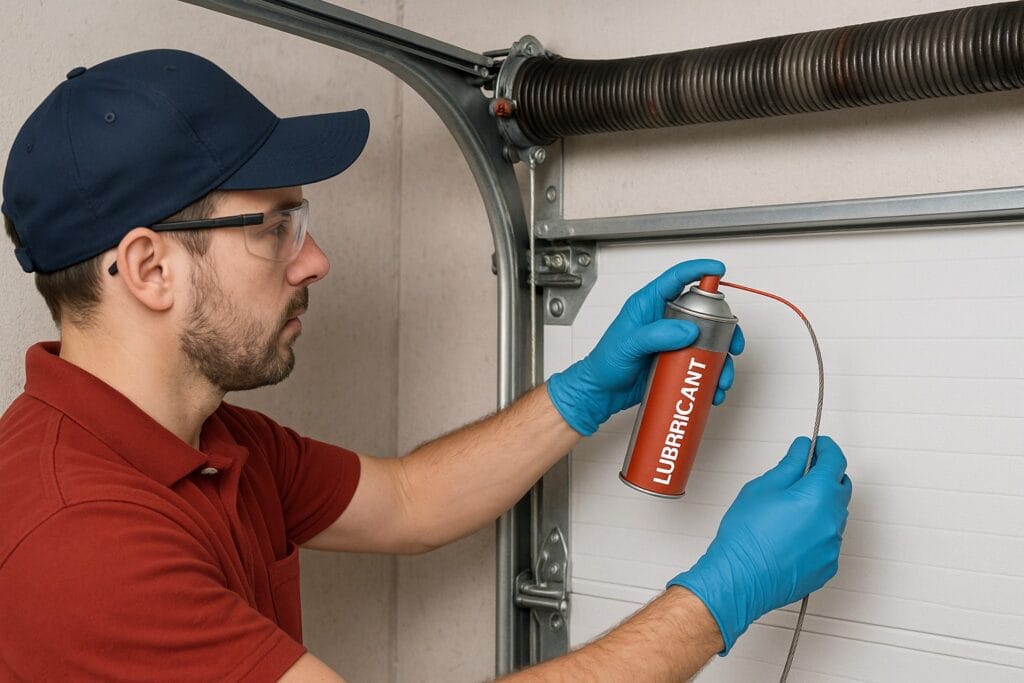How Garage Door Cable Replacement Can Prevent Further Damage

It started with a sharp noise, like a whip snapping. A homeowner in the Mayfair section of Philadelphia heard the sound as their garage door suddenly tilted sideways, leaving one corner scraping the floor and the other hanging dangerously midair. They quickly called Moruzzi Garage Door Center. Our technician found the root of the issue: a broken garage door cable. The failure not only disabled their door, but it also bent the track, strained the garage door opener, and left the home vulnerable until we completed the repair. The damage could’ve been far worse, had they not acted quickly.
Garage doors may seem simple, but they rely on a complex system of moving parts, including torsion springs, pulleys, and cables, that must all work in harmony. Among these, garage door cables play a crucial role in balancing the heavy weight of the door. According to safety statistics from the U.S. Consumer Product Safety Commission, garage doors cause over 20,000 injuries annually, many of them related to sudden door drops caused by cable failure. This makes cable replacement not just a matter of repair, but one of serious safety.
At Moruzzi Garage Door Center, we specialize in garage door cable replacement for both residential and commercial properties across Philadelphia, PA. In this guide, we’ll walk you through how timely cable replacement prevents further damage, improves safe operation, and extends the lifespan of your entire garage door system.
What Are Garage Door Cables and Why Are They So Important?
Garage door cables are steel-wound cords that work with your springs, either torsion or extension, to lift and lower your door. These cables wind around a cable drum at the top of the door and connect to the bottom bracket near the door’s base. As the door opens or closes, the cables and springs control the motion, ensuring the system runs with the right amount of tension.
If you’ve ever used a garage door opener and noticed the door lifting smoothly and evenly, you have the cables to thank. They prevent the heavy weight of the door, often over 200 pounds, from crashing down. Whether you’re using universal doors, a Henderson, or any standard or custom system, the cables are central to proper function. Without strong, well-maintained cables, your garage door system becomes a safety hazard and mechanical liability.
Common Causes of Garage Door Cable Wear and Damage
Garage door cables don’t last forever. Even with regular garage door maintenance, wear and tear are unavoidable. Here are some of the most common reasons cables fail:
1. Corrosion from Moisture and Salt
Philadelphia’s climate exposes garage doors to a lot of moisture, especially during winter months when salt is used on the roads. This can cause the steel cables to corrode, weakening them over time. Rust eats away at the tiny strands of steel, reducing their strength and increasing the chance of sudden breakage.

2. Friction from Constant Use
Each time the door moves, the cables are wound and unwound. This constant movement causes internal friction within the cable strands and between the cables and the cable drum. Over time, the friction causes strands to fray and break apart.
3. Poor Alignment or Tension
If your springs are misaligned or the pulleys are damaged, extra tension is placed on one side of the system. This uneven pressure can accelerate wear on the cables. In some cases, the cable may jump off the drum altogether, a situation that needs immediate attention.
4. Age and Lack of Maintenance
Even the best garage door cables have a lifespan. Most are rated for around 10,000 cycles, about 7–10 years of regular use. Without inspections or regular upkeep, old cables can become brittle and more likely to snap unexpectedly.
Signs It’s Time for Garage Door Cable Replacement
Catching cable problems early can prevent catastrophic failure. Here are some clear signs it’s time for garage door cable replacement:
- Frayed or Unraveled Wires: Visible damage like frayed edges, broken strands, or kinked cables means the cable is at the end of its life.
- Loose or Slack Cables: If the cables appear droopy or off-track, the tension is incorrect, or the cable may be unraveling internally.
- Door Opens Crookedly: When one side rises faster than the other, it’s a classic sign of uneven cable tension or a broken cable.
- Loud Squeaking or Popping Sounds: Unusual noises during operation could signal that the cable is rubbing or slipping from the drum.
- Door Gets Stuck Midway: If the door stops during movement, the cable might be tangled, detached, or broken entirely.
If you notice any of these issues, stop using the door immediately and call for professional help. Continuing to operate a damaged system can cause greater issues and risk serious injury.
What Happens If You Ignore a Worn or Broken Garage Door Cable?
Letting a worn or broken garage door cable go unrepaired doesn’t just cause inconvenience; it can cause a chain reaction of serious problems:
1. Door Panel Damage
When one cable snaps, the garage door becomes lopsided. One side may slam to the ground while the other remains stuck in the track, twisting the entire door. This often leads to bent or cracked panels that require full door replacement.
2. Spring and Pulley Strain
Without the support of cables, torsion springs and extension springs are forced to carry the full weight of the door. This excess strain causes them to wear out or snap sooner, which is both expensive and dangerous to fix.
3. Track and Roller Misalignment
A crooked garage door places uneven pressure on the rollers and track. This may cause rollers to pop out or tracks to bend, making the entire door system unusable.
4. Opener Motor Failure
Garage door openers aren’t meant to lift the door alone. When cables fail, the opener overcompensates, causing the motor to overheat or the gears to strip, often requiring a full opener replacement.
5. Risk of Personal Injury
A garage door cable failure can cause the door to fall suddenly. Without the cable tension holding it up, the door may drop hundreds of pounds onto anything or anyone below. That’s why replacing cables is a critical safety step.
Step-by-Step Guide: The Garage Door Cable Replacement Process
While some DIY guides claim garage door cable replacement is an “easy step,” it requires specific knowledge, high-tension handling, and the right tools to perform safely. Here’s what the professional replacement process looks like at Moruzzi Garage Door Center:
Step 1: Safety First
We begin by ensuring all team members use personal protective equipment (PPE), including safety glasses, gloves, and proper footwear. Our techs also disconnect the opener and secure the door in place with C-clamps or locking pliers.
Step 2: Release Spring Tension
The next step is to carefully release the spring tension. Whether the system uses torsion springs or extension springs, this must be done slowly and precisely to avoid injury.
Step 3: Remove the Old Cable
With tension released, we detach the old cable from the bottom bracket and unwind it from the cable drum or pulley system. We inspect the drum for wear or burrs that could damage the new cable.
Step 4: Install the New Cable
A new cable, sized to your specific door model, is securely installed. We loop it around the drum and attach it to the bottom bracket using proper tensioning techniques. We ensure it tracks properly without slack or twists.
Step 5: Reset and Test the System
We re-engage the spring tension and test the door’s movement manually first, then with the garage door opener. The goal is smooth, even motion with no jerks, squeaks, or uneven lifting.
Step 6: Lubrication and Final Inspection
All moving garage door parts, from rollers to hinges to springs, are lubricated for smooth operation. We also complete a multi-point inspection to ensure the garage door system is balanced and ready for safe use.

Why Professional Help Is Always Recommended
Garage door cable replacement is not your average DIY project. The springs in your garage door hold tremendous high tension, and a simple misstep can result in severe injury or even death. That’s why professional garage door technicians like those at Moruzzi are trained to handle this task with proper tools, knowledge, and safety precautions.
Professionals also ensure the entire garage door system is examined. A broken cable often signals other underlying issues, like worn pulleys, cracked drums, or aging garage door springs. Replacing the cable without correcting these can lead to future failure.
With our experience and specialized equipment, we complete the replacement process efficiently and safely, restoring your garage door to like-new condition.
How Regular Maintenance Can Extend the Life of Your Garage Door Cables
One of the easiest ways to prevent cable problems is through regular garage door maintenance. Here’s what you should do:
- Inspect cables monthly for fraying, corrosion, or slack.
- Lubricate moving parts (except the cables themselves) with a silicone-based lubricant to reduce wear.
- Test the door balance by disconnecting the opener and lifting the door halfway; it should stay in place. If not, spring tension or cables may be off.
- Schedule annual tune-ups with a professional to check drums, pulleys, springs, and tracks.
Routine maintenance not only catches cable issues early but also protects your garage door opener, springs, and panels from unnecessary wear.
Commercial vs. Residential Cable Replacement Needs
At Moruzzi Garage Door Center, we serve both homeowners and businesses, each with unique challenges:
Residential Garage Doors
Homeowners often overlook their garage doors until a problem arises. But a broken garage door cable can trap your car inside or leave your home exposed to theft. We offer same-day services for homeowners to get their systems back up and running fast.
Commercial Garage Doors
For businesses, downtime is costly. A stuck overhead door can halt shipments or delay production. Our commercial services include 24/7 emergency repairs, high-cycle cable options, and preventative maintenance plans to reduce interruptions.
How Can Moruzzi Garage Door Center Help You?
If your garage door cables are worn, rusted, or broken, now is the time to act. Waiting too long can lead to serious damage, costly repairs, or even personal injury. At Moruzzi Garage Door Center, we provide expert garage door cable replacement and maintenance services designed for long-lasting, safe operation.
Here’s why customers across Philadelphia trust us:
- 🛠️ Certified technicians with years of experience
- 🔧 Advanced tools and safety-first repair methods
- 🧰 Full-service inspections with every visit
- 🕒 Same-day appointments and emergency repairs
- 💯 Workmanship guarantee on all garage door repairs
We service all brands and models, including Garador, Henderson, and universal doors, with precision and care.
📍 Address: 1300 Market St, Philadelphia, PA 19107
📞 Phone: (267) 732-0907
Call us today or schedule your appointment online to experience safe, efficient, and professional garage door service.
Final Thoughts
Your garage door is one of the largest and most-used systems in your home or business, and its safety depends on parts like cables, springs, drums, and pulleys working together. By recognizing the signs of wear, understanding the risks, and scheduling prompt garage door cable replacement, you protect your property, your loved ones, and your investment.
Garage door cable issues rarely fix themselves. The longer you wait, the greater the damage and cost. Don’t take unnecessary risks; partner with professionals who understand the inner workings of your garage door system from top to bottom.
Moruzzi Garage Door Center is here to help you maintain safe, smooth, and reliable operation every step of the way. Whether it’s time for an inspection, a minor fix, or a full cable replacement, we’ve got your back, because your peace of mind is our top priority.
Frequently Asked Questions (FAQs)
1. How long does garage door cable replacement take?
In most cases, professional garage door cable replacement can be completed in about 30 to 60 minutes. However, if additional parts like springs or drums are also damaged, the repair time may be slightly longer.
2. Can I replace garage door cables without replacing the springs?
Yes, cables and springs can be replaced independently if only one is damaged. However, both parts work together under high tension, so it’s essential to inspect the entire system to ensure safe and balanced operation.
3. How often should garage door cables be inspected?
Garage door cables should be visually inspected at least once every three months. For optimal safety and performance, it’s best to include cable checks during annual professional maintenance.
4. Are there different types of garage door cables?
Yes, the two main types are torsion spring cables and extension spring cables, each designed for specific garage door systems. Choosing the correct type and size is crucial for safe and effective operation.
